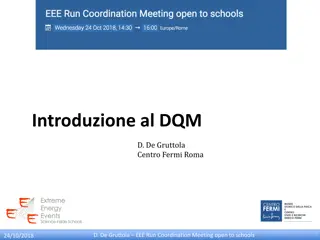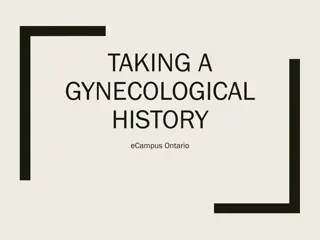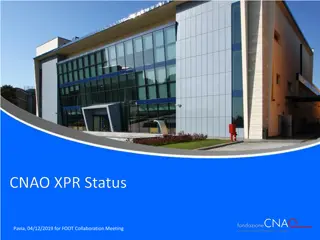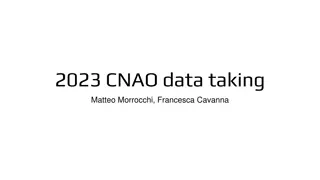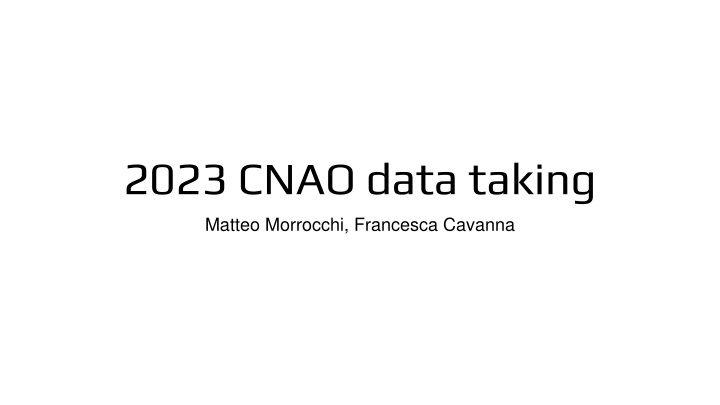
2023 CNAO Data Taking Schedule and Measurement Plan
Explore the detailed schedule for the 2023 CNAO data taking event, including the assembly timeline, accelerator downtime, beam tuning, installation activities, and safety documentation requirements. Learn about the measurement plan involving calibration tasks for the calorimeter, vertex, and IT, as well as magnet alignment runs and more.
Download Presentation

Please find below an Image/Link to download the presentation.
The content on the website is provided AS IS for your information and personal use only. It may not be sold, licensed, or shared on other websites without obtaining consent from the author. If you encounter any issues during the download, it is possible that the publisher has removed the file from their server.
You are allowed to download the files provided on this website for personal or commercial use, subject to the condition that they are used lawfully. All files are the property of their respective owners.
The content on the website is provided AS IS for your information and personal use only. It may not be sold, licensed, or shared on other websites without obtaining consent from the author.
E N D
Presentation Transcript
2023 CNAO data taking Matteo Morrocchi, Francesca Cavanna
Schedule Monday Tuesday Wednesday Thursday Friday Saturday Sunday 18 Sept. Start of Calorimeter Assembly 19 Sept. 20 Sept. 21 Sept. 22 Sept. 23 Sept. 24 Sept. 25 Sept. 26 Sept. 27 Sept. 28 Sept. 29 Sept. 30 Sept. All materials for Table at PI 1 Oct. 2 Oct. Measurement B Field LNF 3 Oct. Measurement B Field LNF 4 Oct. Measurement B Field LNF 5 Oct. Measurement B Field LNF 6 Oct. Measurement B Field LNF 7 Oct. 8 Oct. 9 Oct. 10 Oct. 11 Oct. 12 Oct. Accelerator downtime 13 Oct. Accelerator downtime 14 Oct. Accelerator downtime 15 Oct. Accelerator downtime
Schedule Monday Tuesday Wednesday Thursday Friday Saturday Sunday 16 Oct. Accelerator downtime 17 Oct. 18 Oct. 19 Oct. 20 Oct. 21 Oct. Night Shift (8h) Beam Tuning 22 Oct. Night Shift (6h) Beam Tuning 23 Oct. Table and magnet at CNAO Installation 30 Oct. 24 Oct. Installation 25 Oct. Installation 26 Oct. Installation 27 Oct. Night Shift (8h) Calo Screen Saver Run 28 Oct. Night Shift (8h) Vertex + IT Calibration Installation 4 Nov. After. Shift (8h) 29 Oct. Night Shift (6h) 31 Oct. 1 Nov. 2 Nov. 3 Nov. 5 Nov. After. Shift (8h) 6 Nov. Night Shift (6h) 7 Nov. Night Shift (6h) Emulsion Run TW calib 8 Nov. Uninstallation 9 Nov. Uninstallation 10 Nov. No Material in the room 11 Nov. Next Exp. In Exp. Room. 12 Nov.
Documentation Need to fill the required safety modules: - Module for radioprotection, one for each participant (please check the expiration date of your medical certificates and send a copy to me) - Declaration of possession of requirements for professional and technical suitability, one for each institution (the module expires after 1 year) - Safety Approval Form, one for the whole experiment All modules are available here. The deadline to collect the documentation is September, the 22nd In addition: - An online course (0.5 h) needs to be attended, and a form needs to be filled. The course expires after 3 years. - Each Local Coordinator should send to us the participant list specifying (if possible) dates of arrival and departure, radioprotection status, and the means of transportation used by each group (i.e. to optimize the number of vans to be used).
Measurement Plan - Calibration Calorimeter (8h) Calibration with screen saver, 4 positions, as many energies as possible. - Reconstruction of the response curve for each crystal - 10000 evts x crystal x energy 2h 9 energies for of the calorimeter Vertex and IT (6h) Cross-check the threshold for each sensor - Collect statistics with tracks in different region of the detector need for a thick target in front of the vertex to scatter the beam The calibration needs to be done with and without magnetic field, with more than one energy TW (1h) Scan moving the TW using the same energy/ies used in the fragmentation runs. MSD Just a quick alignment run without magnet 5 different points in the detector (same energy/ies used in the frag. runs)
Measurement Plan - Frag. Measurements 4 Shifts - 28 hours total (6 + 8 + 8 + 6) 1-2 hours at the begin of the first run needed for alignment acquisitions In the last data taking we acquired data with the following event rate: - about 200 Hz with MB trigger - below 100 Hz with fragmentation trigger To demonstrate the capability to work in inverse kinematic we need to acquire data with C2H4target 29 Oct. 4 Nov. 5 Nov. 6 Nov. Align. Align.
Measurement Plan - Emulsion Run Two bricks, C and C2H4. Emulsions need to leave CNAO the 8 of November (preferably in the morning) to go back to Naples. Is a radioprotection survey needed before emulsions leave CNAO? Naples will send a sample to CNAO ad a brief description of the samples that will be irradiated with the estimated total number of particles. Integration of the Emulsion support in the table needs to be discussed. Need for a scan spanning an area of 2.4 cm x 2.4 cm with a 15-18 kg brick. Use of CNAO magnets, verify the method to counts the impinging particles on the brick. Separated meetings with a working group to understand how to execute the irradiation with the required resolution on the number of particles. First meeting Sept. 19that 9:00.
Detector Geometry Since we have new/larger detectors compared to the last data taking, it would be nice to collect the channel map (including the right orientation and position of each channel) for each detector before the data taking. 31 Calorimeter modules (9 scintillator each). How do we arrange the modules respect to the TW? 279 X-Y TW crossing can be covered.
Installation For the CALO screen saver run, no other detector should be on the beam line, this calibration will be performed at the beginning of the data taking. So it would be nice that: - All the detectors will be installed on the beamline by the 26thto test the whole apparatus (without beam). - Move the detectors out of the beamline, except for the calorimeter, the 27th. - Mount again the morning of the 28th Remember: Installation dates may change according to the availability of the construction site for the access with the van(s). The site need to be informed few days in advance to have access granted. Since the calorimeter will be transported at CNAO fully assembled, it would be easier to access from the construction site also with this detector. The more the system gets complex, the more the installation needs to be planned and performed in steps - Let s avoid having 20 people at the same time in the cave - Space will be reduced compared to last data taking Step by step plan divided into 3-4 days to coordinate the activities in the room (4-5 shifts)
Installation The following big components need to be moved to CNAO: - Calorimeter - Table - Magnet (Also a transpallet from Perugia is needed for the installation) I would like to check that we have a plan for each component From Pisa: van with tail lift to load and unload the table without need for a forklift in the construction site. (23-26 October, 7-10 November) From Torino: From Frascati:
Uninstallation All the materials have to be removed from the experimental room before November, 11th. Materials cannot be left at CNAO, some exceptions for limited volumes can be discussed with Marco, but please let us know in advance if this is needed, so to identify a possible solution. Also the uninstallation needs the coordination with the construction site. It is difficult to perform the whole radioprotection survey on November, 8th, the exact schedule of the surveys will be decided later (need to be known a bit in advance to schedule the rent of the vans)
Notes Documents in preparation: - FOOT Installation documentation - Geometry and detector maps documentation - Safety Approval Form This presentation is continuously updated and can be found at the following link: https://docs.google.com/presentation/d/1Z5GhAc4msEjNLL_mqJcTx-BF5PDRneSg/edit#slide=id.p1





